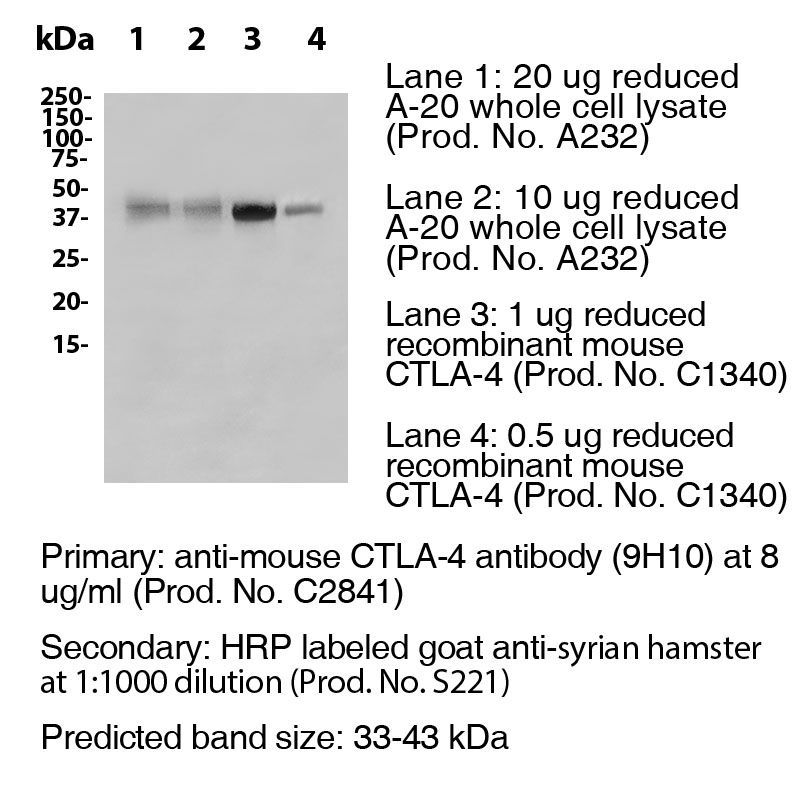Anti-Mouse CD152 (CTLA-4) [Clone 9H10] — Purified in vivo PLATINUM™ Functional Grade
Anti-Mouse CD152 (CTLA-4) [Clone 9H10] — Purified in vivo PLATINUM™ Functional Grade
Product No.: C2841
Clone 9H10 Target CTLA-4 Formats AvailableView All Product Type Monoclonal Antibody Alternate Names CD152, Cytotoxic T Lymphocyte-Associated Antigen-4, Ly-56 Isotype IgG Applications B , in vivo , WB |
Data
Antibody DetailsProduct DetailsReactive Species Mouse Host Species Syrian Hamster Recommended Dilution Buffer Immunogen Mouse CTLA-4-human IgG1 fusion protein Product Concentration ≥ 5.0 mg/ml Endotoxin Level <0.5 EU/mg as determined by the LAL method Purity ≥98% monomer by analytical SEC ⋅ >95% by SDS Page Formulation This monoclonal antibody is aseptically packaged and formulated in 0.01 M phosphate buffered saline (150 mM NaCl) PBS pH 7.2 - 7.4 with no carrier protein, potassium, calcium or preservatives added. Due to inherent biochemical properties of antibodies, certain products may be prone to precipitation over time. Precipitation may be removed by aseptic centrifugation and/or filtration. Product Preparation Functional grade preclinical antibodies are manufactured in an animal free facility using in vitro cell culture techniques and are purified by a multi-step process including the use of protein A or G to assure extremely low levels of endotoxins, leachable protein A or aggregates. Pathogen Testing To protect mouse colonies from infection by pathogens and to assure that experimental preclinical data is not affected by such pathogens, all of Leinco’s Purified Functional PLATINUM™ antibodies are tested and guaranteed to be negative for all pathogens in the IDEXX IMPACT I Mouse Profile. Storage and Handling Functional grade preclinical antibodies may be stored sterile as received at 2-8°C for up to one month. For longer term storage, aseptically aliquot in working volumes without diluting and store at ≤ -70°C. Avoid Repeated Freeze Thaw Cycles. Country of Origin USA Shipping Next Day 2-8°C RRIDAB_2829599 Each investigator should determine their own optimal working dilution for specific applications. See directions on lot specific datasheets, as information may periodically change. DescriptionDescriptionSpecificity Anti-Mouse CLTA-4 (Clone 9H10) recognizes an epitope on Mouse CD152. This monoclonal antibody was purified using multi-step affinity chromatography methods such as Protein A or G depending on the species and isotype. This antibody was also pathogen tested and third-party certified by IDEXX BioReseach to meet the lowest mycoplasma specification and free of any viral pathogens of concern. Background CTLA4 (Cytotoxic T-Lymphocyte Antigen 4) also known as CD152, is a protein which is expressed on the surface of Helper T cells and plays an important regulatory role in the immune system.1 CTLA4 is a member of the immunoglobulin superfamily, expressed on the surface of Helper T cells. CTLA4 transmits an inhibitory signal to T cells.2,3 CTLA4 is potentially therapeutic in autoimmune diseases4, such as rheumatoid arthritis, HIV, autoimmune thyroid disease, multiple sclerosis and may also be useful during organ transplantation and cancer treatment. The 9H10 antibody has been shown to promote T cell co-stimulation by blocking CTLA-4 binding to the B7 co-receptors, allowing for CD28 binding. Antigen Distribution Activated T cells Ligand/Receptor CD80 (B7.1), CD86 (B7.2) Function Negative regulator of T cell activation NCBI Gene Bank ID UniProt.org Research Area Immunology Leinco Antibody AdvisorPowered by AI: AI is experimental and still learning how to provide the best assistance. It may occasionally generate incorrect or incomplete responses. Please do not rely solely on its recommendations when making purchasing decisions or designing experiments. Clone 9H10 is commonly used in vivo in mice to block CTLA-4 (CD152), thereby enhancing T cell activation and augmenting anti-tumor immune responses. Key in vivo applications include:
All these applications depend on the antibody’s ability to block the interaction between CTLA-4 and its ligands (CD80/CD86), thereby modulating T cell responses for research into cancer, autoimmunity, and immune regulation. In summary: The most common in vivo use of clone 9H10 in mice is to functionally block CTLA-4 for cancer immunotherapy modeling, Treg modulation, and study of T cell-mediated immune responses. Commonly used antibodies or proteins alongside 9H10 (anti-CTLA-4) in the literature include antibodies targeting CD28, B7 family members (CD80/CD86), and other checkpoint inhibitors such as anti-PD-1 or anti-PD-L1. Additionally, other anti-CTLA-4 antibody clones—such as 9D9, UC10-4F10, and 4F10—are frequently used in similar experimental contexts. Key proteins and antibodies used in conjunction with 9H10:
Alternative context: If referring to the 9H10 antibody against influenza hemagglutinin, other stalk-targeting broadly neutralizing antibodies, such as CR8020 and CR8043, are often used for comparative binding and functional studies. For most research applications involving CTLA-4 (the canonical 9H10 clone), combinations typically feature:
These combinations enable exploration of immune activation, checkpoint pathways, and potential synergies in immunotherapy. The clone 9H10, an anti-CTLA-4 antibody, has been extensively studied in scientific literature for its role in immunotherapy, particularly in cancer research. Here are some key findings from citations involving clone 9H10:
Overall, clone 9H10 is valued for its ability to selectively deplete intra-tumoral Tregs, promote T cell activation, and enhance antitumor responses, making it a potent tool in cancer immunotherapy research. Dosing regimens of clone 9H10 (anti-CTLA-4) in mouse models show considerable variation depending on the specific tumor model, experimental goal, and administration route, but most commonly involve 100–200 μg per mouse given intraperitoneally every 3 days. Some protocols use different dose levels, routes, or frequencies based on therapeutic and toxicity considerations. Key dosing approaches include:
Summary Table—Representative Dosing Regimens for Clone 9H10 in Mouse Models:
These regimens are frequently adapted based on experimental considerations, observed toxicities, and specific aims (e.g., monotherapy, combination therapy, immune memory studies). Always reference published protocols particular to the tumor model and research objective for precise implementation. References & Citations1. Allison JP, et al. 1995. Science 270:932.
Technical ProtocolsCertificate of Analysis |
Formats Available
Prod No. | Description |
|---|---|
C1756 | |
C1748 | |
C1749 | |
C1750 | |
C1752 | |
C1753 | |
C1754 | |
C1614 | |
C2841 |
 Products are for research use only. Not for use in diagnostic or therapeutic procedures.
Products are for research use only. Not for use in diagnostic or therapeutic procedures.



